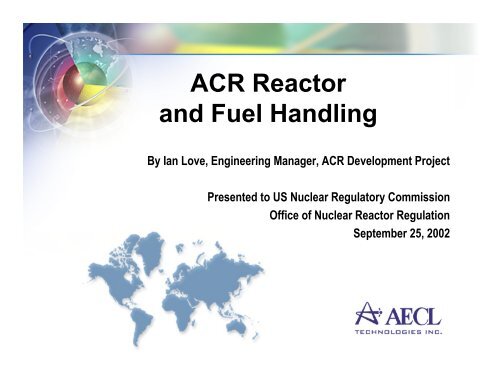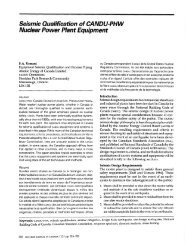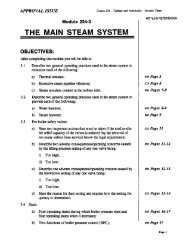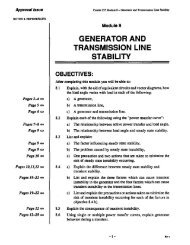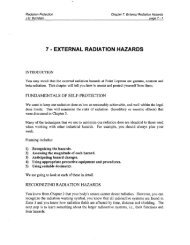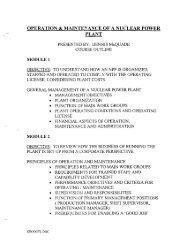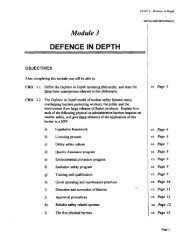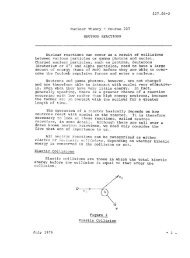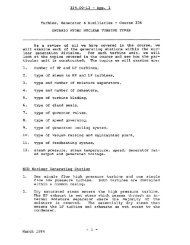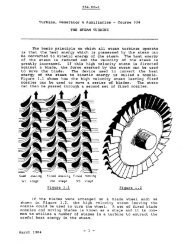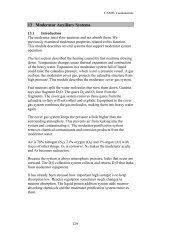ACR Reactor and Fuel Handling - Bill Garland's Nuclear ...
ACR Reactor and Fuel Handling - Bill Garland's Nuclear ...
ACR Reactor and Fuel Handling - Bill Garland's Nuclear ...
Create successful ePaper yourself
Turn your PDF publications into a flip-book with our unique Google optimized e-Paper software.
<strong>ACR</strong> <strong>Reactor</strong><br />
<strong>and</strong> <strong>Fuel</strong> H<strong>and</strong>ling<br />
By Ian Love, Engineering Manager, <strong>ACR</strong> Development Project<br />
Presented to US <strong>Nuclear</strong> Regulatory Commission<br />
Office of <strong>Nuclear</strong> <strong>Reactor</strong> Regulation<br />
September 25, 2002
<strong>Reactor</strong> Design Basis<br />
• The <strong>ACR</strong> reactor is based on a typical CANDU design<br />
• Features an array of fuel channels passing horizontally<br />
through cal<strong>and</strong>ria containing the moderator heavy<br />
water<br />
• Cal<strong>and</strong>ria is a horizontal cylindrical vessel closed at<br />
each end by circular flat plates (cal<strong>and</strong>ria tube sheets)<br />
• The cal<strong>and</strong>ria tubes pass horizontally through the<br />
cal<strong>and</strong>ria <strong>and</strong> restrain the cal<strong>and</strong>ria tube sheets<br />
• The cal<strong>and</strong>ria is enclosed by end shields<br />
• The shield tank encloses <strong>and</strong> supports the cal<strong>and</strong>ria<br />
<strong>and</strong> end shields<br />
Pg 2
<strong>ACR</strong>-700 <strong>Reactor</strong> Size<br />
Darlington Cal<strong>and</strong>ria<br />
8.5m(334.6 inches)I.D.<br />
C6 Cal<strong>and</strong>ria<br />
7.6m(299.2 inches)I.D.<br />
<strong>ACR</strong>-700 Cal<strong>and</strong>ria<br />
5.2m(204.7 inches)I.D.<br />
Pg 3
<strong>ACR</strong> <strong>Reactor</strong> Design utilizes<br />
proven features of CANDU<br />
• The cal<strong>and</strong>ria contains heavy water moderator<br />
• The end shields contain light water <strong>and</strong> shielding balls.<br />
• The shield tank contains light water, which serves as<br />
both a thermal <strong>and</strong> a biological shield<br />
• The cool moderator is independent of the hot,<br />
pressurized light water coolant in the fuel channels<br />
Pg 4
<strong>ACR</strong> Cal<strong>and</strong>ria & Shield Tank Assembly<br />
Pg 5
<strong>ACR</strong> <strong>Reactor</strong> Design utilizes<br />
proven features of CANDU<br />
• The shield tank has an integral rectangular extension<br />
extending up <strong>and</strong> supporting the reactivity<br />
mechanisms deck<br />
• Thimbles guide reactivity mechanisms from the<br />
reactivity mechanisms deck to the top of the cal<strong>and</strong>ria<br />
• The assembly of the cal<strong>and</strong>ria <strong>and</strong> integrated shield<br />
tank <strong>and</strong> reactivity mechanisms deck is called the<br />
Cal<strong>and</strong>ria Shield Tank Assembly (CSTA)<br />
Pg 6
Darlington/Bruce<br />
Cal<strong>and</strong>ria <strong>and</strong> Shield Tank<br />
<strong>ACR</strong> Cal<strong>and</strong>ria Shield<br />
Tank Assembly<br />
Pg 7
Reactivity Control Units<br />
• Reactivity mechanisms include:<br />
− Reactivity control devices (control absorber units <strong>and</strong><br />
mechanical zone control units)<br />
− Safety shutdown systems (shutoff units for shutdown system<br />
1, <strong>and</strong> liquid injection nozzles for shutdown system 2)<br />
− Neutron flux measuring devices (self-powered flux detector,<br />
fission chamber <strong>and</strong> ion chamber units)<br />
− All reactivity mechanisms operate in the low temperature, low<br />
pressure moderator environment<br />
− Designs are simple, rugged, require little maintenance, are<br />
highly reliable <strong>and</strong> are based on CANDU 6 designs<br />
− Reactivity control units are testable on line.<br />
Pg 8
Reactivity Mechanisms Layout<br />
Pg 9
<strong>Fuel</strong> Channel<br />
• Supports twelve fuel bundles<br />
• Facilitates flow of coolant past fuel to steam generators<br />
• Accommodates dimensional <strong>and</strong> performance changes<br />
during operating life<br />
• Permits inspection <strong>and</strong> replacement, if necessary<br />
(Single-Channel <strong>and</strong> Large-Scale Retubing)<br />
• Prevents damage to other channels <strong>and</strong> cal<strong>and</strong>ria in<br />
accident scenarios if pressure tube failure occurs<br />
• Pressure boundary consists of closure plugs (2), end<br />
fittings (2), <strong>and</strong> pressure tube.<br />
Pg 10
<strong>ACR</strong> <strong>Fuel</strong> Channel<br />
Pg 11
Lattice pitch<br />
PT material<br />
PT wall thickness<br />
PT max. operating temperature<br />
PT max. operating pressure<br />
PT max. operating flux (n/m 2 /s)<br />
Cal<strong>and</strong>ria tube material<br />
Cal<strong>and</strong>ria tube wall thickness<br />
<strong>Fuel</strong> channel operating life<br />
<strong>Fuel</strong> Channel Design<br />
CANDU 6<br />
286 mm (11.26”)<br />
Zirconium 2.5wt%<br />
Niobium alloy<br />
4.2 mm (0.165”)<br />
313.2 o C (596 F)<br />
11.1 MPa (1610 psi)<br />
3.7x10 17<br />
Zircaloy-2<br />
1.4 mm (0.055”)<br />
25 years at 80%<br />
capacity<br />
220 mm (8.66”)<br />
Zirconium 2.5wt%<br />
Niobium alloy<br />
327.7 o C (622 F)<br />
13 MPa (1886 psi)<br />
4.1x10 17<br />
<strong>ACR</strong><br />
6.5 mm (0.256”)<br />
Zircaloy-4<br />
2.5 mm (0.098”)<br />
30 years at 90%<br />
capacity<br />
Pg 12
<strong>ACR</strong> <strong>Fuel</strong> Channels with Feeders<br />
Pg 13
<strong>ACR</strong> Channel Closure<br />
Pg 14
<strong>ACR</strong> Pressure Tube Rolled Joint<br />
Pg 15
Assessments of <strong>ACR</strong> Pressure<br />
Tube Aging<br />
• Assessments of PT deformation, H ingress, fracture <strong>and</strong><br />
DHC are based on existing models <strong>and</strong> data<br />
− Extrapolated to 30 years <strong>and</strong> considers <strong>ACR</strong> conditions<br />
− Assume highest power channel, worst case material variability<br />
− Conservative estimates of benefits of improvements to PT (as<br />
compared with historical data on which models are based)<br />
• Effects of deformation <strong>and</strong> H ingress will be acceptable<br />
over 30 years at 90% capacity<br />
• Fracture behavior will also be acceptable<br />
• Testing will be performed to confirm assessments results<br />
Pg 16
<strong>Fuel</strong> H<strong>and</strong>ling System<br />
• The <strong>ACR</strong> <strong>Fuel</strong> H<strong>and</strong>ling System is an evolution of the<br />
CANDU 6 system<br />
• It consists of :<br />
− New fuel transfer <strong>and</strong> storage<br />
− On-power fuel changing<br />
− Spent fuel transfer <strong>and</strong> storage<br />
Pg 17
On-Power Refueling<br />
Pg 18
<strong>Fuel</strong> H<strong>and</strong>ling System<br />
• Provides a safe <strong>and</strong> reliable method to refuel reactor on power<br />
• <strong>ACR</strong> system is designed to:<br />
− simplify manufacture, installation <strong>and</strong> commissioning<br />
− reduce O & M costs<br />
• Major improvements in the design include:<br />
− <strong>Fuel</strong>ing machine head <strong>and</strong> carriage simplified<br />
− Elimination of D2O from fueling machine system<br />
− Electric drives replace oil hydraulic drives<br />
− <strong>Fuel</strong>ing machine support enhanced<br />
− Spent fuel transferred in water (H2O) Pg 19
CANDU 6 <strong>Fuel</strong>ing Machine<br />
FM Magazine<br />
FM Ram<br />
FM Snout<br />
Pg 20
<strong>Fuel</strong>ing Machine on <strong>Reactor</strong><br />
Pg 21
<strong>ACR</strong> <strong>Fuel</strong> H<strong>and</strong>ling Layout<br />
Pg 22
On-Power <strong>Fuel</strong>ing<br />
• Controls the global power distribution in the <strong>ACR</strong> core<br />
• <strong>Fuel</strong>ing scheme consists of changing:<br />
− 2 of 12 bundles per channel visit<br />
− 21 channels per week<br />
• Requires 4 hours/ day fueling everyday or 6 hours/day fueling 4<br />
days per week<br />
• Channels to be fueled are scheduled to:<br />
− Control the global flux distribution<br />
− Maximize fuel discharge burn-up<br />
• Improves fuel economy<br />
• Allows on-power removal of defective fuel<br />
Pg 23
Spent <strong>Fuel</strong> Transfer<br />
• Spent fuel is<br />
transferred in<br />
water<br />
• Double<br />
containment<br />
isolation at both<br />
ends of transfer<br />
tube<br />
Pg 24
CANDU Spent <strong>Fuel</strong> Bay<br />
<strong>ACR</strong> Spent <strong>Fuel</strong> Storage<br />
Pg 25
Dry <strong>Fuel</strong> Storage<br />
Module Stores 12,000 Bundles (26 Modules required for 60 years storage)<br />
Pg 26
Summary<br />
• Compact <strong>ACR</strong> core results in smaller lattice pitch <strong>and</strong><br />
reduced volume of D2O moderator<br />
• <strong>ACR</strong> <strong>Reactor</strong> design is an evolution of existing CANDU<br />
reactor designs<br />
• <strong>Fuel</strong> Channel design has increased margins with<br />
extended operating life<br />
• <strong>Fuel</strong> H<strong>and</strong>ling system design has been optimized <strong>and</strong><br />
simplified to improve overall performance <strong>and</strong><br />
availability<br />
Pg 27
Pg 28


